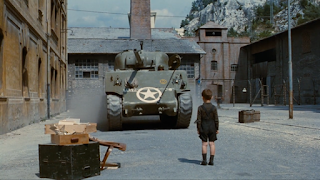WEEKLY APPRECIATION || Life Is Beautiful
Hello Netizens,
On Friday, I had the chance to watch 'Life Is Beautiful' (1997), an Italian film directed by Roberto Benigni. It is a comedy-drama set in Italy and takes place before and after World War II.
It tells a story of an Italian Jewish man, Guido, falling in love with a school teacher. The film is inspired by the book 'In the End, I Beat Hitler', and Begini's father's experience in a German labour camp.
The film has won multiple awards, Grand Prix, nine David di Donatello Awards, Best Film in Italy and three academy awards.
Life Is Beautiful is a film that is meant to illustrate the beauty of life and plant hope in the hearts of the watchers. The main character is an over-optimistic individual with an extremely charming personality, and when faced with tragedies he laughs at the face of misery and smiles till the very end. The love interest is Dora, a conserved woman who then shows a little more of her perkiness.
Their relationship starts with the cliche I bumped into you scene, which happens again in their second meeting. Due to this film being produced in 1997, I believe we can let it slide (it still bothered me while watching). Every character that has been introduced early on in the film, is meant to appear later on with more importance to the plot and also to drive it forward. For instance; the government official Guido's eggs happened to break on his head, is revealed then to be Dora's fiance.
At the beginning of the film Guido's best friend mentions a theory by a German philosopher, Arthur Schopenhauer, "If you think, it will be." Benigni's use of theory in the film is, ironic. Schopenhauer view of life and what he meant by his theory is, that life is aimless and painful and it will only lead to unhappiness. Guido uses the Schopenhauer method with hope, as he tries to catch Dora's attention across the theatre room or to save his son from the Nazi soldiers. The Schopenhauer method plays an important theme through out the film.
Another theme carried in the film, is the ability to control coincidences, or the sense of controlling coincidences. Guido, in multiple instances, is provided with a 'coincidences' and he makes a decision that somehow allows him to control them. For example: He notices Dora is across the street and he wants to talk to her. However, he has to hide behind his friend's back from the government official he humiliated a couple days ago. When the government official leaves, Guido decides to jump out his friend's back when Dora is nearest to them and surprises her by jumping out of nowhere!
Another theme carried in the film, is the ability to control coincidences, or the sense of controlling coincidences. Guido, in multiple instances, is provided with a 'coincidences' and he makes a decision that somehow allows him to control them. For example: He notices Dora is across the street and he wants to talk to her. However, he has to hide behind his friend's back from the government official he humiliated a couple days ago. When the government official leaves, Guido decides to jump out his friend's back when Dora is nearest to them and surprises her by jumping out of nowhere!
During the scenes where the characters move to the concentration camp, we can see the shift in their personalities. We see Dora for the first time firm and serious, it is almost scary, when she demands the Nazi soldier to stop the train, and hasn't twitched even a bit from the condescending looks the Nazi soldier gives her. Guido, in the other hand, tries to maintain his positive outlook on life. If not for himself, he is doing it for the sake of his son. It came off a bit annoying to me at the beginning, however, later on I began to feel the sad undertones behind his words.
In the concentration camp, Dora is seen emotionless almost all the time. She has been taken away from her husband and son, and life now is on pause. When she is told about the gas chambers, yes she knows something that could save her family, however, she is equally as powerless as she was before knowing about the gas chambers and can't do anything to help them.
The film provides for a need to tell a story for the people about life, how uncontrollable it is and filled with coincidences. Moreover, it tells the story of the people who had to go through the Holocaust and what they had to give up. The film has a 'Uses and gratification theory' approach with its story telling and message.
Life Is Beautiful also work as a healing film rather than a reminder of what happened during the Holocaust. It wants to cheer individuals up and remind them that, life in fact is Beautiful.
In the concentration camp, Dora is seen emotionless almost all the time. She has been taken away from her husband and son, and life now is on pause. When she is told about the gas chambers, yes she knows something that could save her family, however, she is equally as powerless as she was before knowing about the gas chambers and can't do anything to help them.
The film provides for a need to tell a story for the people about life, how uncontrollable it is and filled with coincidences. Moreover, it tells the story of the people who had to go through the Holocaust and what they had to give up. The film has a 'Uses and gratification theory' approach with its story telling and message.
Life Is Beautiful also work as a healing film rather than a reminder of what happened during the Holocaust. It wants to cheer individuals up and remind them that, life in fact is Beautiful.
References:






Comments
Post a Comment